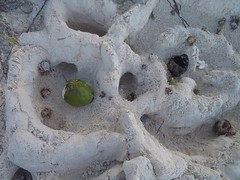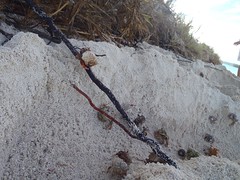However, one question remained. Why did we let out more anchor chain? The boys were curious, so the next day we had a little discussion of the physics of anchors and a little demonstration.
 |
| old style |
 |
| modern plough |

However, letting out more chain has another positive effect that isn't always obvious and this is where the demonstration came in. What I wanted to show is that the weight of the anchor chain alone significantly improves the holding and in calmer conditions is almost the only force that is needed to hold our boat in place. The anchor chain makes the top side of the triangle and is quite heavy. As the angle decreases, the force (wind) required to keep the chain (top of the triangle) straight increases (it's a non-linear increase in effort but I don't know what the factor is).
To demonstrate this we took one of our long, heavy dock lines, attached it to a cleat at the bow then ran it back along the boat deck to the cockpit. First I had the boys try to lift the line and hold it straight from 10 feet from the bow. They did this with ease. Then they stepped back 5 feet and tried again. This time it was more difficult. Then they stepped back another 5 feet. At this point Aidan couldn't get the line to stay straight except when he yanked on it (this simulates a boat surging on its anchor in the wind). They stepped back another 5 feet and now Aidan couldn't straighten the line at all and Austin could only do it by yanking. Back another 5 feet and neither of them could straighten it.
We discussed that each time they stepped back they needed to lift and keep raised more line, which increased the total weight they needed to lift. Each time they stepped back they were also making the line more horizontal, which has a similar effect to moving farther from the fulcrum of a lever (only it has the inverse effect of increasing the amount of force required rather than reducing it).



